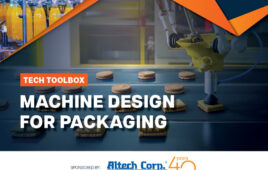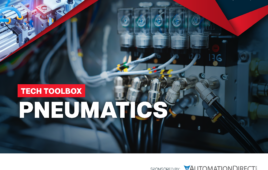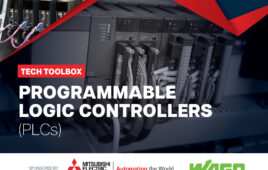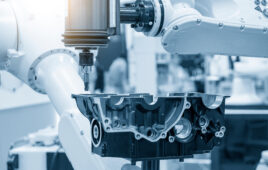
By Steve Sullivan, Training Supervisor, Rittal North America LLC
The materials you chose for your industrial enclosures will impact the lifespan and performance of the electronic and automation components housed within. With numerous materials available, each offering different protective advantages, how can you be confident in your choice? The answer: it comes down to your application.
Here are some considerations to keep in mind.
Environment. To what sort of environment will the enclosure be exposed? Are there corrosive gas, vapor, liquid, or dust particles present? Is there exposure to manufacturing byproducts? What about weather — is your enclosure braving the elements? And to what temperatures will the enclosure be exposed?
EMI Interference. Will EMI affect the performance of installed components? Will the enclosure be exposed to radio or EMI waves? If so, metallic enclosures offer a higher barrier to radio and electromagnetic interference than some other choices.
Strength. The required material strength needs to be determined when specifying an enclosure. What is the total weight of the components to be housed? Metallic enclosures are stronger and able to carry greater loads than non-metallic enclosures but are susceptible to denting with impact. Non-metallic enclosures are resistant to some impact but cannot withstand as much weight or support as heavy a load as metallic enclosures.
Modifications. What modifications will you need to make? Adding cutouts and holes to stainless steel enclosures is far more difficult than modifying carbon steel enclosures. Fiberglass is much easier than steel to modify but can splinter and produce a very fine, potentially harmful dust.
Climate Control. Metallic enclosures can conduct and dissipate heat, so carbon or stainless steel is the best choice of material if thermal transfer is desired. Fiberglass and polycarbonate enclosures have much slower thermal transfer. Therefore, any heat transfer would require fans or air conditioning. The material in a non-metallic enclosure essentially acts as an insulator, keeping internal temperature warm when ambient temperature is cool and vice versa.
Conductivity. Metallic enclosures conduct electricity and therefore require grounding to ensure operator safety when installing or maintaining internal equipment. Non-metallic enclosures do not conduct electricity, which means the installed equipment is isolated from the enclosure, providing a safety barrier to operators. With both metallic and non-metallic enclosures, external grounding of the installed equipment is required to ensure a clear path to earth ground.

Once you’ve thought about your requirements, next consider your options.
Painted carbon steel is the most cost-effective metallic enclosure material. The paint finish consists of an inner layer of primer and an outer layer of powder for some manufacturers, wet spray only, or power coating only for others. Power coatings produce a durable and scratch-resistant surface that passes requirements for outdoor paint. In the case of accidental scratches, touchup paint should be used to cover exposed bare metal. Resistance to solvents, alkalis, and acids is very limited. Painted carbon steel enclosures are mainly used in indoor applications.
Type 304 stainless steel is an iron-based alloy containing between 18% and 20% chromium. Type 304 is corrosion resistant and provides protection from corrosive solvents, alkalis, and some acids. Stainless steel is ideal for applications that are exposed to washdown cleaning processes, such as food and beverage processing. Type 304 stainless steel enclosures are used in both indoor and outdoor applications.
Type 316 stainless steel contains molybdenum, which enables it to provide better overall corrosion resistant properties than Type 304. Additional material properties include an improved resistance against sulfates, bromides, chlorine, sea water, high temperatures, and some special acids. Resistance to sea water makes 316 stainless steel ideal for marine environments. Since Type 316 has very good resistance to chemical attack, it is often specified in pharmaceutical manufacturing applications in which excessive metallic contamination must be avoided. Type 316 stainless steel enclosures are used in both indoor and outdoor applications.
Fiberglass reinforced polyester (known as “fiberglass”) is impact and corrosion resistant. Fiberglass is a lightweight, extremely strong material which consists of plastic reinforced by fine fibers of glass. Fiberglass enclosures are well suited for corrosive, high temperature environments. Some fiberglass enclosures are immersion proof: they can be submerged in water for specific periods of time while fully protecting the contents of the enclosure. The disadvantages of specifying a fiberglass enclosure include color fade and fiber bloom due to extended exposure to sunlight but this can be mitigated with the use of UV inhibitors or acrylic paint.
A polycarbonate is a very durable plastic formed from a thermoplastic polymer. Polycarbonate has greater impact resistance than fiberglass and suffers no ultraviolet light deterioration. Polycarbonate is much easier to modify as compared to fiberglass, producing cleaner holes and cutouts. Polycarbonate enclosures have a longer product life and are more weather resistant as compared to fiberglass enclosures.
The correct enclosure must be chosen based on environmental conditions, required strength, modification capabilities, and weight considerations, but, of course, cost is a factor. Strictly based on enclosure investment, 316 stainless steel is generally a higher investment, followed by 304 stainless steel. Fiberglass and polycarbonate materials would be the next options in terms of investment needed, followed by painted carbon steel, which would be lesser of an investment.
Regardless of investment considerations, however, it is imperative to choose the correct material based on your application. Any cost savings realized at the beginning of a project will be insignificant compared to long-term costs needed to correct problems caused by choosing the wrong enclosure. Choosing the right enclosure material, however, will help ensure that the components and equipment housed inside will be sufficiently protected from the environment, electronic interference, and physical abuse for years to come.
To learn more about Rittal’s industrial enclosure solutions, visit rittal.com.
Sponsored content by Rittal
Filed Under: SPONSORED CONTENT




